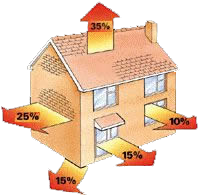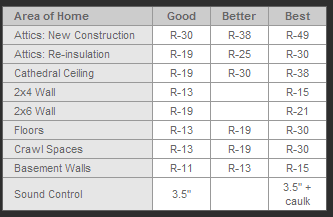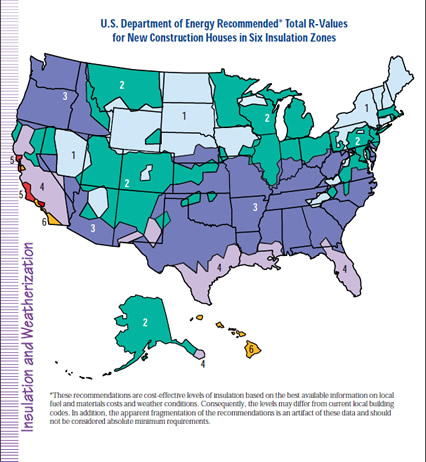Insulation Basics
INSULATION BASICS
Why Insulate?
It may be out of sight, in your walls or attic, but insulation is a critically important building material for your home. That’s because it’s one of the most thermally efficient and cost-effective ways to save energy while making homes quieter and more comfortable. Often made from recycled and renewable resources, insulation is also a sustainable building product that positively impacts our environment, helping reduce energy consumption and the effects of global warming. Though it’s been used successfully for decades in homes worldwide, insulation is still affordable regarding energy efficiency.
Insulation keeps your home warmer in the winter, which lowers your heating costs. In the summer insulation keeps your home cooler, which eases the load on your air conditioner.
Insulation can actually absorb sound, reducing the unwanted noise from appliances, audio equipment, conversation and other sources of sound that are transmitted through your walls and floors. Insulation also keeps your family more comfortable by making it easier for your furnace or air conditioner to maintain a constant temperature.
As insulation saves energy it significantly decreases the generation of harmful air pollutants to the atmosphere. In fact, according to a Harvard study, insulating homes in the U.S. to even modest 2000 International Energy Conservation Code levels would reduce hundreds of thousands of tons of nitrous oxide and sulfur oxide released into the atmosphere each year.
Not only does insulation contribute to cleaner air, it is an inherently “green” product in terms of assessing its environmental impact over its lifetime. Often manufactured with recycled and renewable resources, every pound of insulation ultimately saves twelve times more energy than it takes to produce it. So along with greater energy savings, insulation delivers a measurable impact on our environment, reducing the amount of energy consumption and pollution.
Insulation also prevents the depletion of our natural resources. Today’s fiber glass insulation contains more than 25% recycled glass and uses renewable resources such as sand. In fact, according to the Glass Packaging Institute, Fiber glass insulation is the largest secondary market for recycled glass containers.
How Insulation Works?
 To maintain comfort in your home, the heat lost in winter must be replaced by your heating system and the heat gained in summer must be removed by your air conditioner. Insulating ceilings, walls, and floors decreases this heat flow by providing an effective resistance to the flow of heat.
To maintain comfort in your home, the heat lost in winter must be replaced by your heating system and the heat gained in summer must be removed by your air conditioner. Insulating ceilings, walls, and floors decreases this heat flow by providing an effective resistance to the flow of heat.
Heat flows naturally from a warmer to a cooler space. In winter, heat flow moves directly from heated living spaces to adjacent unheated attics, garages, and basements, or to the outdoors; or indirectly through interior ceilings, walls, and floors – wherever there is a difference in temperature. During the cooling season, heat flows from outdoors to the house interior.
Adding insulation beneath drywall in a typical wall configuration can increase the sound transmission coefficient STC rating. In most homes, walls between rooms are only marginally effective at blocking noise. Made of drywall and lumber alone, these interior or partition walls have poor Sound Transmission Class STC ratings. An STC rating is a number used to characterize the acoustic performance of a wall, floor or ceiling—the higher the STC rating, the less sound will be transmitted between rooms. By far the easiest and most economical method for controlling noise is to install insulation in the wall cavity.
A vapor-resistant membrane (commonly called a vapor retarder) attached to batt or roll insulation decreases the possibility of moisture vapor condensing to water within the structure.
Even though you need some moisture in the air you breathe, too much moisture in your home can cause problems. When moist air comes in contact with a cold surface, some of the moisture may leave the air and become liquid, or condense. If moisture condenses inside a wall, or in your attic, you will not be able to see the water, but it can cause a number of problems.
What is An R-Value?
An R-value is a rating used to measure how well insulation can resist heat flow. The higher the R-value, the greater the insulating properties and the slower heat and cold flows through it. Because insulation with higher R-values is more energy-efficient, the colder the climate, the higher the required R-value.
Different areas of the home have different recommended R-values, depending on what materials are used and how much space is available for insulation. The table below shows the suggested R-values for homes.

*please consult your local building code for the minimum R-value required.

Insulation FAQs
If you’re a home builder, you can build faster for less. An insulation professional will save you time on the front end and back end of a job. Experienced installers can insulate your homes faster than framers or general contractors, so you can keep your craftsmen focused on what they do best. Plus, you can be sure the job will be done the right the first time, eliminating callbacks. A professional contractor’s expertise can help you in other ways too. A pro has access to extensive information about codes OSHA requirements and the most effective application techniques. They’re not only familiar with how to insulate a variety of framing and construction techniques but how to provide proper ventilation around attic insulation to prevent structural damage.
If you are a home owner, hiring a professional installer makes sense. Properly insulating your home really pays-not only by reducing your utility bills but by also adding comfort and value to your home. A professional installer will save you time and money you wouldn’t otherwise installing yourself. They have the specialized products and technical expertise to insulate your home quickly, making sure your home delivers the greatest comfort and highest energy savings possible. For example, a professional installer will know your proper installed R-value as well as have the latest information on building codes.
If you’re a home builder, you can build faster for less. An insulation professional will save you time on the front end and back end of a job. Experienced installers can insulate your homes faster than framers or general contractors, so you can keep your craftsmen focused on what they do best. Plus, you can be sure the job will be done the right the first time, eliminating callbacks. A professional contractor’s expertise can help you in other ways too. A pro has access to extensive information about codes OSHA requirements and the most effective application techniques. They’re not only familiar with how to insulate a variety of framing and construction techniques but how to provide proper ventilation around attic insulation to prevent structural damage.
If you are a home owner, hiring a professional installer makes sense. Properly insulating your home really pays-not only by reducing your utility bills but by also adding comfort and value to your home. A professional installer will save you time and money you wouldn’t otherwise installing yourself. They have the specialized products and technical expertise to insulate your home quickly, making sure your home delivers the greatest comfort and highest energy savings possible. For example, a professional installer will know your proper installed R-value as well as have the latest information on building codes.
The amount of insulation you need depends on where you live. The U.S. Department of Energy (DOE) has established thermal (or R-value) recommendations for homes based on geographic zones. Or, check with your utility company or state energy office.
Fiber glass insulation is available in two types: loose fill (blown in) and blanket. Loose fill insulation comes in bags. Blanket insulation comes in batts and rolls in various R-values, widths and lengths.
